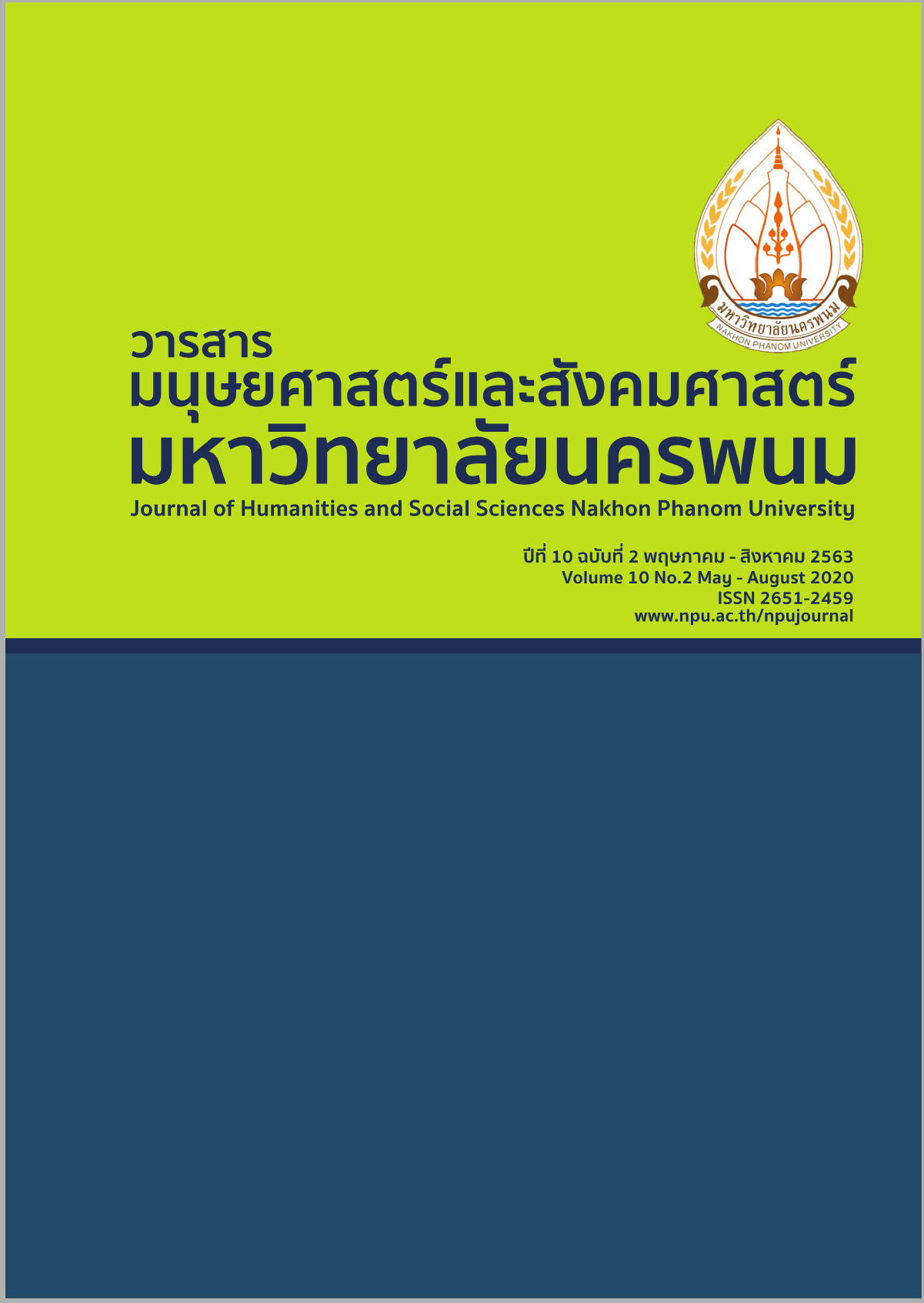Development of learning activities for Thai music of Mathayomsuksa 2 students according to Simpson’s skills development
Main Article Content
Abstract
The purposes of research were 1) to develop Thai music learning activities of secondary school students. Year 2, according to the concept of Simpson's practical skills development With efficiency according to the criteria 80/80 2) to find the effectiveness index of organizing learning activities of Thai music, according to Simpson's practical skills development Of Mathayom Suksa 2 3) to study the satisfaction of Mathayom Suksa 2 students who learned by learning activities, according to developing Simpson's practical skills. The sample group used in this research was Mathayom Suksa 2 students at Phrabatnasingpittayakhom School, Rattanawapi District, Nong Khai Province, affiliated with Office of Secondary Educational Service Area 21, 1st semester, academic year 2018, 1 classroom, 24 students. The tools used in this research are : 1) Learning plan, according to the concept of Simpson's 10 practical skills development. 2) Learning achievement test of Ankhalung Band, 30 items, with the power of discrimination from 0.45 to 0.67 and the confidence of the whole test is 0.85. 3) Assessment form for recording playing Thai music and 4) The satisfaction of students studying according to the concept of developing Simpson's practical skills. Statistics used in data analysis were percentage, mean, standard deviation.
The results of the study were as follows: 1) Learning management plan according to Simpson's practical skills development have an efficiency of 83.59 / 84.72 2) The effectiveness index of the art learning management plan according to Simpson's practical skills development, is equal to 0.7746 and 3) Students studying with the art learning plan according to Simpson's practical skills development were satisfied at the highest level. When considering each item, it was found that giving the opportunity to ask questions has the highest mean, followed by students who like to get showing initiative. And students like to study through speaking, listening and performing respectively.
Article Details
References
กฤตมุข ไชยศิริ. (2561). การพัฒนาชุดการสอนโดยใช้รูปแบบการสอนทักษะปฏิบัติของซิมพ์ซันเรื่องการร้อยลูกปัด วิชาการงานอาชีพและเทคโนโลยีสำหรับนักเรียนชั้นประถมศึกษาปีที่ 5 โรงเรียนวัดอ่างแก้ว (จีบ ปานขำ). วาสารศิลปากรศึกษาศาสตร์วิจัย, 10(1), 179.
ซารัญฎา ผลจันทร์. (2558). การพัฒนาความคิดสร้างสรรค์ ความรับผิดชอบ และทักษะการเขียนภาพระบายสี โดยใช้ชุดฝึกทักษะการเขียนภาพระบายสีโปสเตอร์ตามหลักการของเดวีส์ร่วมกับเทคนิค STAD บนพื้นฐานหลักปรัชญาของเศรษฐกิจพอเพียงกลุ่มสาระการเรียนรู้ศิลปะชั้นมัธยมศึกษาปีที่ 3. วารสารบัณฑิตศึกษามหาวิทยาลัยราชภัฏสกลนคร, 12(59), 51-62.
ทิศนา แขมมณี. (2553). ศาสตร์การสอน องค์ความรู้เพื่อการจัดกระบวนการเรียนรู้ที่มีประสิทธิภาพ. กรุงเทพฯ: สำนักพิมพ์แห่งจุฬาลงกรณมหาวิทยาลัย.
นนทลี พรธาดาวิทย์. (2560). การพัฒนาการจัดการเรียนรู้เชิงรุกในวิชาการจัดการเรียนรู้. วารสารวิจัย มทร. กรุงเทพฯ, 11(1), 85-94.
ประสาท เนืองเฉลิม. (2554). หลักสูตรการศึกษา (พิมพ์ครั้งที่ 2 ปรับปรุงแก้ไขเพิ่มเติม). มหาสารคาม: สำนักพิมพ์มหาวิทยาลัยมหาสารคาม.
ยศวัฒน์ เชื้อจันอัด. (2558). การพัฒนารูปแบบการเรียนรู้พลศึกษาด้านทักษะปฏิบัติ สำหรับนักเรียนชั้นมัธยมศึกษาปีที่ 3. วารสารการวัดผลการศึกษา มหาวิทยาลัยมหาสารคาม, 21(2), 236-246.
Harrow, A.J. (1972). A taxonomy of the psychomotor domain: A Guide for Developing Behavioral Objectives . New York: David McKay.
Simpson, R. D. and D. K. Brown. (1977). Validiating Science Teaching Competencies Using the Delphi : Method. Science Education, 61(6), 211–213.


